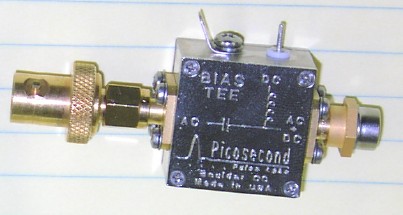
APOLLO Fast Photodiode

We use a Hamamatsu G4176 GaAs photodiode with a 20 ps risetime in conjunction with a 20 GHz Picosecond Pulse Labs 5545 bias tee, reporting 12 ps rise time capability. This picture shows, from left to right, a BNC-to-SMA adapter, the bias tee, and the small SMA-threaded Hamamatsu photodiode at far right.
We (primarily Daniel Miller) have confirmed negligible time jitter (< 10 ps) in the laser fire time reported by this photodiode/bias-tee combination.
The photodiode is to sit in the laser enclosure, and will be triggered by the roughly 0.1% of the green laser light not directed out of the laser by the output dichroic. (See the laser output-optics page.) In this way, the photodiode receives a strong, unambiguous pulse at roughly the same time that the green light exits the laser box.
The photodiode plays a crucial role in establishing our laser fire time (as described in the page on the differential calibration scheme). The photodiode also informs the ACM when the laser has fired so that the APD gate can be opened to receive the photons from the telescope corner-cubes. The output signal from the bias tee is fed to an Ortec 9327 Amplifier and Discriminator, acting as a constant-fraction discriminator (CFD), and reporting the time of the pulse edge with very low jitter. As indicated on the system diagram, the 9327 sends a 100 ns TTL pulse to the ACM, and a NIM pulse to the T-50 (aka. booster stage) board which is converted to an ECL START pulse for the TDC.